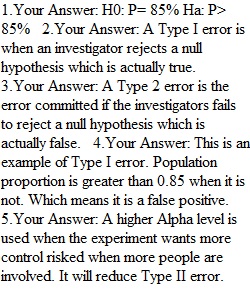


Q Question 1 10 / 10 pts Question Set 1_A State the null and alternative hypotheses for the scenario above. H0: (Hint: The sign for H0 is always =) Ha: (Hint: The sign for Ha is <, >, or ?) Question 2 10 / 10 pts Question Set 1_B What is the definition of a Type I error? Question 3 10 / 10 pts Question Set 1_C What is the definition of a Type II error? Question 4 10 / 10 pts Question Set 1_D Suppose we compute a p-value and conclude that the population proportion of adult residents in this area who use the internet is greater than 0.85 (i.e. 85%), but in fact it is truly not greater than 0.85. Is this an example of a Type I error or a Type II error? Explain your answer. Question 5 10 / 10 pts Question Set 1_E The most common alpha level is 0.05. When is a higher alpha level (e.g. 0.10) typically used? Hint: See https://online.stat.psu.edu/stat200/lesson/6/6.2 Links to an external site.
View Related Questions